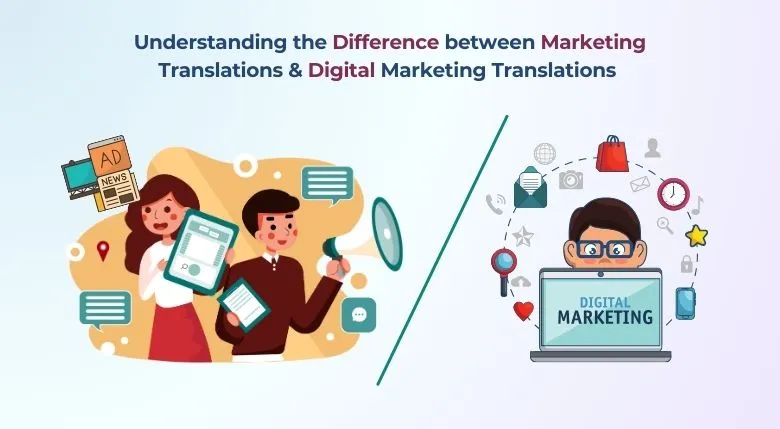 In an era of globalization like today, businesses and industries have come to realize the necessity of converting their marketing materials to efficiently convey their message to their diverse customer groups. However, a common misunderstanding is that all kinds of conversions are the same, especially when it comes to the realm of marketing. In reality, translations in traditional marketing materials are particularly different from digital marketing translation services. In today’s web blog, we shall understand the differences between the two and see how businesses can maximize their global reach and engagement.
In an era of globalization like today, businesses and industries have come to realize the necessity of converting their marketing materials to efficiently convey their message to their diverse customer groups. However, a common misunderstanding is that all kinds of conversions are the same, especially when it comes to the realm of marketing. In reality, translations in traditional marketing materials are particularly different from digital marketing translation services. In today’s web blog, we shall understand the differences between the two and see how businesses can maximize their global reach and engagement.
Nature of the Content
The traditional retail content such as brochures, flyers, and print advertisements are generally static, with formal language designed to deliver a consistent brand message over time. In contrast, digital retail content includes websites, social media posts, online advertisements, blogs, etc. The content here is dynamic and requires updating from time to time to stay relevant and engaging. The language chosen is generally more conversational and candid, and it can vary by platform and target audience. For example, the tone used for an Instagram post will differ widely from that used in an email newsletter.
Customer Engagement
The way customer groups interact with traditional vs online retail materials also differs. Traditional techniques often target a wider customer base and employ a one-way communication approach. For example, printed brochures and pamphlets provide information but are not suitable for immediate interaction or feedback from the customer.
On the other hand, online retail material is intensely interactive. It not only targets a particular segment of the customer demographic, but it can also encourage engagement and communication. Social media platforms and chatbots facilitate businesses to directly communicate with their customers, encouraging a two-way communication channel.
Discover the key differences between marketing translations and digital marketing translations to enhance your global strategy
Click to avail tailored translation services to boost your brand’s reach!
Case Study
An Indian Business Enterprise wanted to establish its foothold in the Korean market. Its target audience was customers aged between 18 to 35 years of age. Recognizing the importance of communication and customer loyalty in today’s time, the enterprise hired a deft Korean marketing translation service to convert all its marketing content into the Korean language. With the help of Korean translations, the enterprise could successfully establish itself and gain revenue from customer loyalty.
It might pique your interest to explore more about Korean document translations and its rise as a demanding language. If you want to learn more, you can read this interesting article on Korean Document Translation: The Way Forward for Global Success.
Localization and Cultural Nuances
Understanding cultural nuances is an important step in both traditional and online marketing, but the approach can vary. The traditional approach requires a high level of cultural accuracy to ensure messages are culturally neutral and acceptable to a broader audience across different markets. In digital translations, localization plays a more important role because online platforms offer more diverse targeting options. This facilitates businesses to customize their messages according to specific cultural contexts. Translators here need to be well-equipped with idiomatic expressions and local cultural references to produce relevant content that is understandable by the local audience.
Speed & Flexibility
The traditional retail process involves product catalogs and brochures, which generally require more time to read and do not produce immediate updates or feedback. The conversion process, therefore, can afford to be more meticulous, ensuring that every detail matches the brand’s tone and message.
The online approach, on the other hand, moves at a much faster pace than the traditional approach. Social media trends have been seen to change overnight, needing quick adaptations and updates to stay relevant. Translators, therefore, need to be more flexible and capable of providing quick turnarounds without compromising quality. A study conducted by the Content Marketing Institute revealed that 60% of marketers produce at least one piece of content every day. This highlights the rapid growth of digital marketing requiring quick and flexible translation solutions to keep up with content demands.
Conclusion
While both traditional and digital marketing translations aim to overcome linguistic and cultural shortcomings, the strategies involved are quite different. Decoding these differences can give businesses an edge over their competitors and help them create more effective campaigns that resonate with the target demographic and generate better sales and higher revenue. By choosing effective language service providers like Somya Translators, who offer the best marketing translation services in India at the most reasonable rates, businesses can improve their global presence and connect with diverse audiences to foster better results.
If you want to explore more about the languages in which you should translate your marketing campaigns, you can read this engaging web blog on Languages in Which You Must Translate Your Marketing Campaigns.







